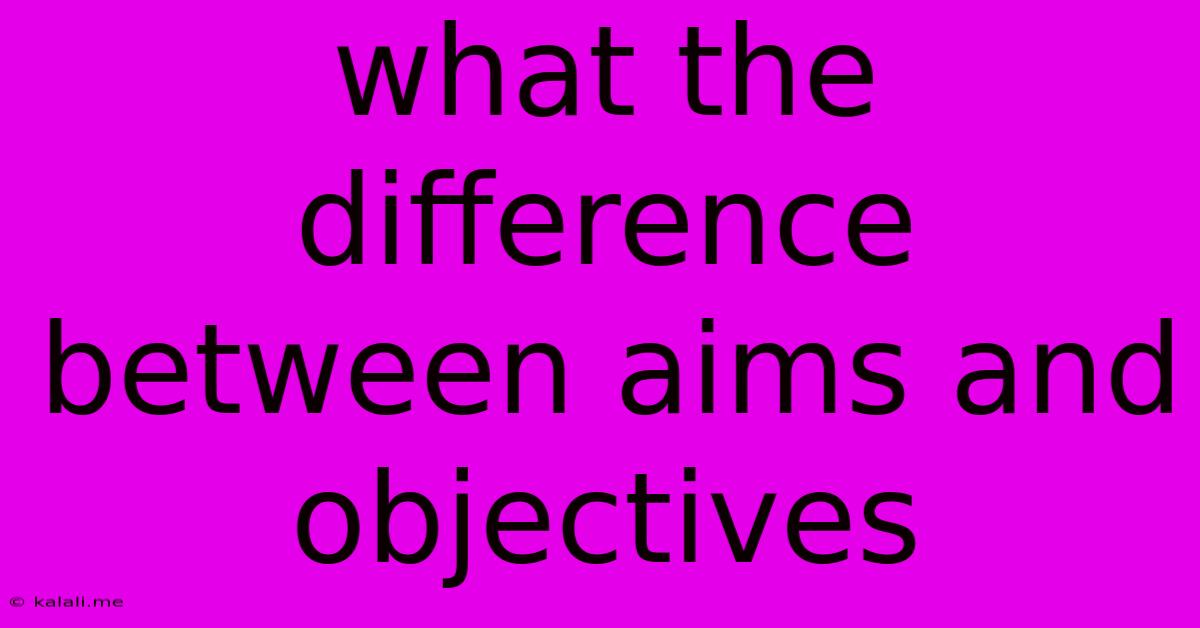What The Difference Between Aims And Objectives
Kalali
Jun 11, 2025 · 3 min read

Table of Contents
Aims vs. Objectives: Understanding the Crucial Difference
Knowing the difference between aims and objectives is crucial for effective planning and achieving your goals, whether in business, personal development, or any other field. While often used interchangeably, they represent distinct levels of specificity and actionability. This article will clarify the distinction, providing practical examples to solidify your understanding. By mastering this difference, you'll be better equipped to create robust plans and successfully navigate toward your aspirations.
What is an Aim?
An aim is a broad, long-term goal that you aspire to achieve. It sets the overall direction and purpose of your efforts, providing a general idea of what you want to accomplish. Aims are often aspirational and inspirational, serving as a guiding star for your endeavors. They are usually less measurable and more qualitative in nature.
Think of an aim as the big picture. It's the overarching vision that motivates your actions.
Key Characteristics of Aims:
- Broad and general: They are not specific or measurable.
- Long-term focus: They are typically achieved over an extended period.
- Qualitative in nature: They focus on the overall desired outcome rather than specific actions.
- Inspirational and motivational: They provide a sense of purpose and direction.
Examples of Aims:
- To improve the company's market share.
- To become a leading expert in my field.
- To promote sustainable living practices within the community.
- To enhance employee satisfaction and retention.
What is an Objective?
An objective is a specific, measurable, achievable, relevant, and time-bound (SMART) step that contributes towards achieving your aim. Objectives break down the larger aim into smaller, manageable tasks, providing a clear roadmap for progress. They are concrete and actionable, allowing for progress tracking and evaluation.
Think of objectives as the milestones on your journey toward your aim. They are the concrete steps you take to reach the final destination.
Key Characteristics of Objectives:
- Specific and measurable: They clearly define what needs to be done and how success will be measured.
- Achievable and realistic: They are attainable given the available resources and time frame.
- Relevant to the aim: They directly contribute to the achievement of the overall aim.
- Time-bound: They have a defined timeframe for completion.
Examples of Objectives:
- Aim: To improve the company's market share.
- Objective: Increase website traffic by 20% in the next quarter through targeted SEO campaigns.
- Objective: Secure partnerships with three key distributors by the end of the year.
- Aim: To become a leading expert in my field.
- Objective: Publish three research papers in peer-reviewed journals within the next two years.
- Objective: Present my research findings at two international conferences by the end of the year.
The Relationship Between Aims and Objectives:
Aims and objectives are intrinsically linked. Aims provide the overarching direction, while objectives provide the specific steps to get there. Without clear aims, objectives lack purpose and direction. Conversely, without specific objectives, aims remain abstract and unattainable. A strong plan includes both, working together in a synergistic relationship.
In Conclusion:
Understanding the difference between aims and objectives is crucial for effective planning and goal achievement. Aims provide the overarching vision, while objectives outline the specific, measurable steps to reach that vision. By clearly defining both, you'll be well-equipped to create a robust plan that guides you toward success. Remember the SMART criteria when setting your objectives, ensuring they are achievable and contribute directly to your overarching aims.
Latest Posts
Latest Posts
-
Somebody Once Told Me That The World Was Macaroni Lyrics
Jul 02, 2025
-
How Old Are You If Born In 1993
Jul 02, 2025
-
What Is 1 4 Of 1 4 Cup
Jul 02, 2025
-
Is Keri Russell Related To Kurt Russell
Jul 02, 2025
-
What Is Half Of 1 4 Teaspoon
Jul 02, 2025
Related Post
Thank you for visiting our website which covers about What The Difference Between Aims And Objectives . We hope the information provided has been useful to you. Feel free to contact us if you have any questions or need further assistance. See you next time and don't miss to bookmark.